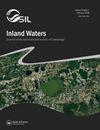短期和动态:耕地上短暂湿地无脊椎动物群落在一个水周期内的演替
IF 2.3
3区 环境科学与生态学
Q1 LIMNOLOGY
引用次数: 0
摘要
本文章由计算机程序翻译,如有差异,请以英文原文为准。
Short and dynamic: succession of invertebrate community over a hydroperiod in ephemeral wetlands on arable land
ABSTRACT The temporal dynamics of aquatic invertebrate communities are known to be influenced by the length of hydroperiods, but only temporary wetlands with relatively long hydroperiods have been well studied. By contrast, few studies have focused on ephemeral wetlands, primarily represented by extremely ephemeral rock pools. In Central Europe, many ephemeral wetlands develop spontaneously directly on arable land, often on the sites of former natural wetlands that have been drained and converted to agricultural land. Here, we focused on aquatic invertebrates in 10 ephemeral pools over periods of inundation to desiccation on arable land in southern Moravia. Despite relatively short hydroperiods of 5–11 weeks, we observed significant changes in community composition, including species replacement. Dynamics differed between macroinvertebrates and microcrustaceans and between different macroinvertebrate feeding and dispersal groups. Predation pressure increased over time and was highest during drying. Passive dispersers were most abundant during the middle phase, whereas the abundance of active dispersers increased throughout the hydroperiod. Because no significant effect of any environmental factor was detected on community change, we hypothesized that community dynamics were driven by differences in species traits and biotic interactions rather than by the changing environment. This study fills a knowledge gap on the temporal dynamics of aquatic invertebrate communities in temporary wetlands by investigating wetlands with short, but not extremely ephemeral, hydroperiods.
求助全文
通过发布文献求助,成功后即可免费获取论文全文。
去求助
来源期刊

Inland Waters
LIMNOLOGY-MARINE & FRESHWATER BIOLOGY
CiteScore
6.10
自引率
9.70%
发文量
34
审稿时长
>12 weeks
期刊介绍:
Inland Waters is the peer-reviewed, scholarly outlet for original papers that advance science within the framework of the International Society of Limnology (SIL). The journal promotes understanding of inland aquatic ecosystems and their management. Subject matter parallels the content of SIL Congresses, and submissions based on presentations are encouraged.
All aspects of physical, chemical, and biological limnology are appropriate, as are papers on applied and regional limnology. The journal also aims to publish articles resulting from plenary lectures presented at SIL Congresses and occasional synthesis articles, as well as issues dedicated to a particular theme, specific water body, or aquatic ecosystem in a geographical area. Publication in the journal is not restricted to SIL members.
 求助内容:
求助内容: 应助结果提醒方式:
应助结果提醒方式:


